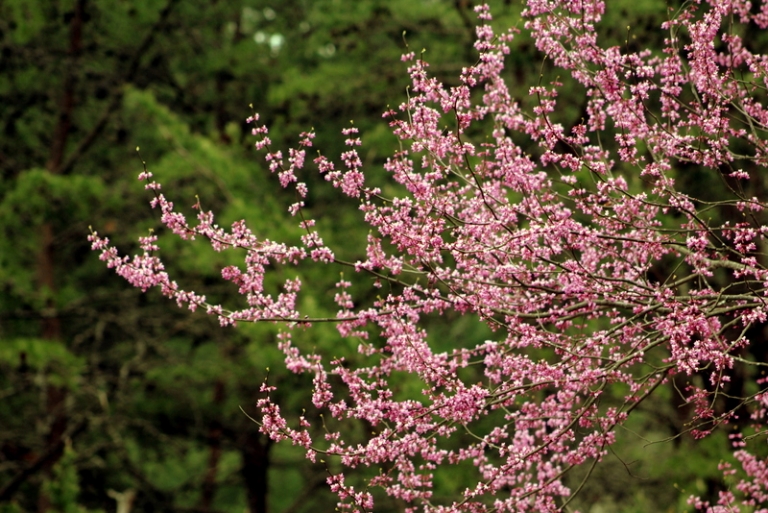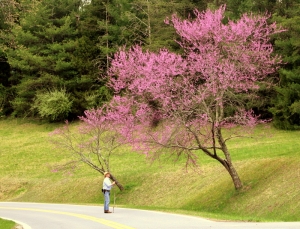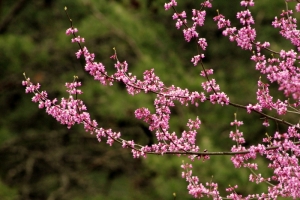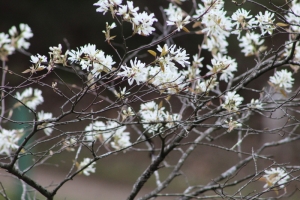
HINTON, W.Va. — Blossoming across the eastern U.S. in spring, redbud trees were notably important during the settlement of the Appalachian Mountains, where they indicated the presence of some of the best soil for farming.
Today, the pink-blooming trees, which also thrive in urban settings, provide an opportunity for city dwellers to experience a natural harvest and experiment with recipes using the tree's sweet flowers, which were shared by mountain folk.

"The redbud and black walnut are two trees that required good soil," said Anthony Tomkowski, Professor Emeritus of Forest Resources Management at West Virginia University.
Settlers in the Appalachians thus learned that the two species indicated the presence of good cropland, which was at a premium in the mountains where the soil is often acidic.
He says Eastern redbud, formerly known as Cercis canadensis, is much more at home in basic or sweet soils that contain more limestone.
"If you want to see a good example of this, travel the interstate up to Coopers Rock State Forest, where you see bands of redbud growing where the limestone outcrops," Tomkowski said.
Redbud may best be known as one of the first native plants to blossom in West Virginia. Along with the white-blossomed serviceberry tree, it famously flowers in the mountains in April.
According to Dr. Gregory Dahle, coordinator for the university's Forest Resources Management and Wood Science and Technology programs, the flowers are edible and make delicious recipes.
"They're edible, and they're tasty," says Dahle, who regularly takes students to see redbud specimens planted on campus.
"The thing about redbud is that it can be found growing in urban settings, so it provides people with an interesting opportunity to interact with this tree in their own backyards," he said.
Among the largest flowering plants native to West Virginia, the redbud grows across North America from Ontario south to northern Florida and is the state tree of Oklahoma.
It typically grows from 20 to 30 feet tall, often on a twisted trunk, which is smooth and dark when young but may later become ridged and scaly with maroon patches.

In spring, vivid pink or magenta flowers blossom along its branches before the tree leafs out. This conspicuous show of color is among the plant's most enduring traits and is one reason it's become such a popular ornamental.
After flowering, a profusion of heart-shaped leaves erupts, followed later in the summer by long seed pods that confirm the plant's membership in the pea family. Often, cercus flowers are present again in late summer and fall, though the bloom is not as conspicuous among the foliage.
Dahle says that he encourages students to taste the sweet flowers, which contain sugar necessary to attract bees. The flowers are what makes redbud recipes so popular.
In southern Appalachia, redbud twigs are often used to season wild meats, and for that reason, the plant there is often called spicewood. However, throughout the Appalachians, the flowers have been used for many purposes. More recently, they've been candied or used as a salad garnish, but traditionally, they became part of a tea, jelly, or pie filling.
Redbud recipes can be sourced online, but here are two simple ones that might satisfy a budding redbud connoisseur.
Redbud Blossom Tea Recipe
Collect five of six cups of redbud blossoms by holding a container under the tree limb and stripping the flowers toward the tip of the branch, letting them fall into the container. Pick out any stems or leaf buds which can add a bitter flavor, and rinse the blossoms to remove any insects. Pour the rinsed petals into a large jar or container.
Bring six cups of water to a roiling boil and pour it over the redbud blooms. Use a wooden spoon to push the petals down into the water. Cover the container and allow the contents to cool. Transfer the container to the refrigerator and allow the blooms to steep for 24 hours.
Once the blooms have steeped, filter the purplish liquid through cheesecloth into a clean jar or bowl and discard the leftover buds.
Redbud Blossom Jelly Recipe
4 cups redbud tea
4 cups cane sugar
1 packet (1.75 ounces) pectin
2 tablespoons lemon juice
1 teaspoon butter
1. Bring redbud tea to a roiling boil.
2. Add pectin, return the mixture to a roiling boil, and continue stirring for 60 seconds.
3. Add sugar, lemon juice, and butter. Return to a rolling boil that can’t be knocked down by stirring, and continue that boil level for another 60 seconds. Remove the pot from the heat.
4. Pour the mixture into sterilized pint or half-pint jars to within a half-inch from the top. Wipe clean the rim of the jar, and screw on an unused lid.
5. If you wish to refrigerate the jelly, allow the jars to cool and refrigerate.
6. For more extended storage, seal the jars. Prepare a hot water bath, then place a wire rack in the bottom of a canner or large pot to prevent the glass jars from contacting the pot bottom. Fill the pot halfway with water, and place it on a burner set at medium-high. Once the jars have been filled and capped, transfer them to the pot. Add enough water to ensure the jars are covered by one-to-two inches of water, and heat the water to a boil. Cover the pot with a tight-fitting lid, boil the jars for 10 minutes, then turn the heat off. Remove the lid, and allow the pot to cool for five minutes. Remove the jars from the water and place them on a towel to cool.
7. After a day or two, check each jar's seal by pressing down on the center of its lid. If the lid won’t flex, the jar is sealed. If it flexes, remove that jar from the fridge and use it within three to four weeks.
Sarvis Tree blossoms signal the arrival of mountain spring

Seasons come and go in the world's temperate regions with many false starts, but in the Appalachian Mountains, settlers knew spring had arrived when the tiny white flowers of the Sarvis Tree blossomed. Read the full story here.
Sign up to receive a FREE copy of West Virginia Explorer Magazine in your email twice weekly. Sign me up!






























